Terrains are a huge part of Card Hunter gameplay. A game board can contain up to five different types of terrain. Each terrain type influence line of sight and movement differently. Understanding and mastering the game board is crucial to winning battles and successful campaigns. The five types of terrains are:
- Open terrain
- Difficult terrain
- Blocked terrain
- Impassable terrain
- Victory terrain
Open Terrain
| An open terrain in a game board represents a tile in which a character can move onto and move pass freely. It does not impede line of sight and movement. Figure 1 shows a dwarf wizard (Dumkolaz) in a Streams of Blood pvp map. The terrain A is an open terrain. The picture on the left shows his line of sight, while the right shows his possible moves. As a dwarf, Dumkolaz can walk two spaces in any direction. You can right-click on any terrain to show its information (Fig. 2).
|
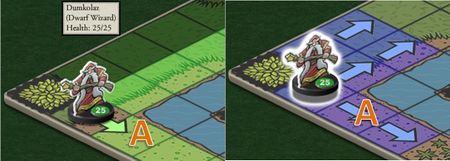 Fig. 1: Open terrain around Dumkolaz |
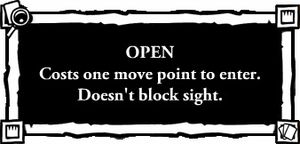 Fig. 2: Open terrain information |
Difficult Terrain
| A difficult terrain represents a tile in which a character can move onto but cannot move pass freely. It does not impede line of sight but all moves into a difficult terrain forces the character to end its move. Figure 3 shows an elf wizard (Lomi) in a Bridge pvp map. The terrain B is a difficult terrain. The picture on the left shows her line of sight, while the right shows her possible moves. As an elf, Lomi can dash four spaces in any direction. However, due to the difficult terrain at B, Lomi is only able to move one space instead of four. You can right-click on any terrain to show its information (Fig. 4).
|
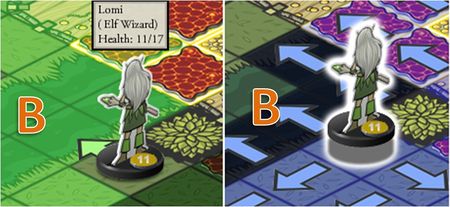 Fig. 3: Difficult terrain around Lomi |
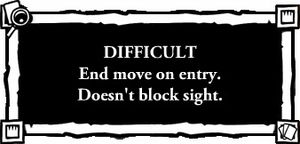 Fig. 4: Difficult terrain information |
Blocked Terrain
| A blocked terrain represents a tile in which a character cannot move onto and cannot see pass. It impedes line of sight and movement. Figure 5 shows a human wizard (Kolo) in a custom scenario pvp map. The terrain C is a blocked terrain. The picture on the left shows his line of sight, while the right shows his possible moves. As a human, Kolo can run three spaces in any direction. However, due to the blocked terrain at C, Kolo is unable to move or see pass the terrain. Blocked terrains typically come with thick black borders. You can right-click on any terrain to show its information (Fig. 6).
|
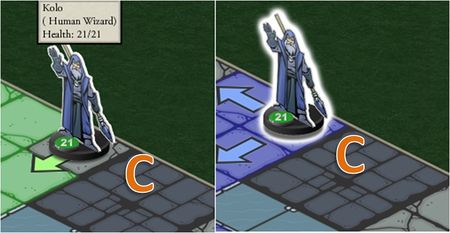 Fig. 5: Blocked terrain around Kolo |
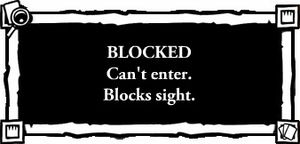 Fig. 6: Blocked terrain information |
Impassable Terrain
| An impassable terrain represents a tile in which a character cannot move onto but can see pass. It does not impede line of sight. Figure 7 shows a dwarf priest (Urista) in a Streams of Blood pvp map. The terrain D is an impassable terrain. The picture on the left shows her line of sight, while the right shows her possible moves. As a dwarf, Urista can walk two spaces in any direction. However, due to the impassable terrain at D, Urista is unable to move into the terrain. She can see pass the terrain to target units beyond. You can right-click on any terrain to show its information (Fig. 8).
|
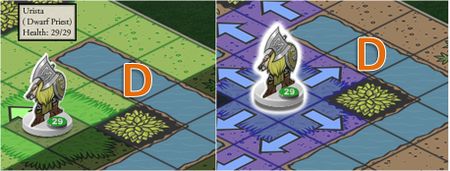 Fig. 7: Impassable terrain around Urista |
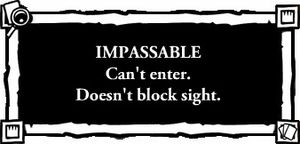 Fig. 8: Impassable terrain information |
Victory Terrain
| Victory terrains belong to a type of special terrain with a gameplay condition. They are easily distinguished by a golden tile overlay. All characters standing on victory terrains in a game board at the end of a round are tabulated. Whichever party that has more characters standing on victory terrains wins a victory point. If it is a tie, neither side scores. Victory points go towards completing a campaign battle or notching a pvp win. Due to its condition, victory terrains are either open terrains or difficult terrains. They do not impede line of sight. Figure 9 shows two parties contesting victory squares in a Temple Tussle pvp map. You can right-click on any terrain to show its information (Fig. 10).
|
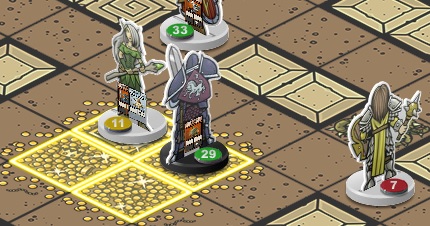 Fig. 9: Characters contesting in victory terrains |
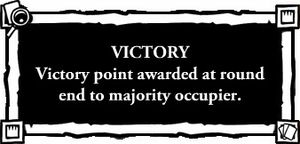 Fig. 10: Victory terrain information |









